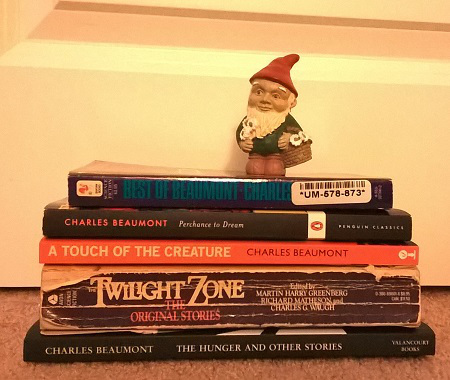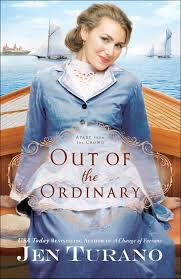
Beaumont(h) – Introduction
[Explanation of Reading Journal Entries/Ratings]
[1] “Adam’s Off Ox” (unpublished until 2000 collection)
A Touch of the Creature
1 out of 5 stars.
The Plot:
Repentant con-man Billy Spiker makes a deal with the Devil: He wants to tell the truth, just once.
The story echoes another (better) Beaumont story, “The Magic Man,” (Post 5, note [181]) which also stars a white con-man traveling in a horse-drawn cart driven by a black assistant, selling “miracles cures.”
“Adam’s Off Ox” gets a low rating for its style (a barely comprehensible backwoodsy dialect) and for having too many plot-beats. When the story should be wrapping up, a second phase begins.
[2] Reference:
Does “Adam’s Off Ox” mean anything?
An idiom meaning an unrecognizable person or thing. According to thefreedictionary.com, “I wouldn’t know him from Adam’s off ox” was the equivalent of the contemporary “I wouldn’t know him from a hole in the ground.”
[3] Vocabulary:
He’d make total paupers a half the men in that room before you could say scatwallix.
(p.20)
Googling “scatwallix” brings up nothing.
[4] Here’s an example of the style I dislike so much (it’s like a worse version of “Sloosha’s Crossin’ ” from Cloud Atlas (notes [68] – [74]):
So he clumb out of the wagon and like to lit on his head in the mud, he was so saturated, but he dint. Made her all right and laughed like a hyeeny, he did, at the pitisul sight of that yeller rig and the old hoss and Ephriam-Ephriam settin big and proud in the pourin down rain, spang in the midst of them Skagit woods.
(p.23)
So many authors drop stories in this weird little corner of genre fiction, there must be an audience for it – but, man, I am not that audience.
[5] What could this mean?
Billy began to tremble like a aspirin.
(p.24)
[6] Reference:
They come to this little town name of Mt. Slocum, which is now the fish hatchery nigh Camano Island.
(p.28)
Mt. Slocum doesn’t appear to be a real town.
There is a Camano Island in the Possession Sound portion of Puget Sound, located in Washington state (where Beaumont lived for a time). I don’t think “Adam’s Off Ox” is supposed to take place in Washington, though, so I’ll assume these names are made up for the story.
[7] “The Beautiful People” (1952)
Best of Beaumont; Perchance to Dream
2.5 out of 5 stars.
The Plot:
In a future where everyone receives surgery to become beautiful, Mary wants to stay the chubby, imperfect girl she is. But no one has ever rejected the procedures before and Mary won’t be allowed to be the first.
[8] Beaumont’s greatest strength is in his openings. Behold:
Mary sat quietly and watched the handsome man’s legs blown off, watched on further as the great ship began to crumple and break into small pieces in the middle of the blazing night. She fidgeted slightly as the men and the parts of the men came floating dreamily through the wreckage out into the awful silence. And when the meteorite shower came upon the men, flying in growing holes through everything, tearing flesh and ripping bones, Mary closed her eyes.
(p.169)
Beaumont was friends with Ray Bradbury and this scene (describing “The Mayorke Disaster”) seems a nod to Bradbury’s story “Kaleidoscope,” (1949) published in The Illustrated Man in 1951 (this is the edition I’m using for page numbers).
Compare Beaumont’s opening (above) with Bradbury’s (here):
The first concussion cut the rocket up the side with a giant can opener. The men were thrown into space like a dozen wriggling silverfish. They were scattered into a dark sea; and the ship, in a million pieces, went on, a meteor swarm seeking a lost sun.
(The Illustrated Man, p.19)
and
It was a second later that he discovered his right foot was cut sheer away. It almost made him laugh. The air was gone from his suit again. He bent quickly, and there was blood, and the meteor had taken flesh and suit away to the ankle.
(The Illustrated Man, p.25)
“I’ve got myself in a meteor swarm, some little asteroids.”
“Meteors?”
“I think it’s the Myrmidone cluster that goes out past Mars and in toward Earth once every five years.”
(The Illustrated Man, p.25)
[9] “Black Country” (1954)
The Hunger
1.5 out of 5 stars.
The Plot:
Drummer Hushup Paige recounts the history and future of Spoof Collins’ jazz group.
A story of jazz musicians, told in a “jazz” style. It’s similar to Beaumont’s later “Night Ride” (Post 7, note [264]), which is also named for the signature song of the jazz group.
“Black Country” is one of Beaumont’s longer stories; it’s all style and little substance. This and “Adam’s Off Ox” (note [1]) were the stories I dreaded going back to in this Beaumont project. (Nice to get them out of the way right off.)
[10] Opening lines:
Spoof Collins blew his brains out, all right – right on out through the top of his head. But I don’t mean with a gun. I mean with a horn.
(p.187)
[11] This. For twenty-one pages:
We planted him out about four miles from town – home is where you drop: residential district, all wood construction. Rain? You know it. Bible type: sky like a month-old bedsheet, wind like a stepped-on cat, cold and dark, those Forty Days, those Forty nights!
(p.187)
Rambling free-form style only works for me if I care about the characters or plot and Beaumont doesn’t give me anything in those departments to hold onto.
[12] Reference:
The coonshouting days were gone alas, except for Satchmo and Calloway.
(p.194)
Satchmo was a nickname of Louis Armstrong.
[13] References:
She’d heard a few records of Muggsy Spanier’s, a couple of Jelly Roll’s.
(p.194)
Francis Joseph “Muggsy” Spanier (1906 – 1967) was a prominent jazz cornet player based in Chicago.
[14]
Rose-Ann took it the hardest (…)
But, you get over things. Even women do, especially when they’ve got something to take its place.
(p.200)
[15] “The Blind Lady” (unpublished until 2000 collection)
A Touch of the Creature
3 out of 5 stars.
The Plot:
Lieutenant John Pearson is sick of seeing Amos Carter and his Court of Last Chance set criminals free.
[16] Translate:
“Vogue la galere!”
(p.189)
French: Let the galley sail on; come what may; away we go
[17] “Blood Brother” (1961)
Best of Beaumont; Perchance to Dream
1 out of 5 stars.
The Plot:
A vampire’s session with a psychiatrist.
Total Night Gallery. And not the good kind.
[18] Great opening line for a dull thud of a story:
“Now, then,” said the psychiatrist, looking up from his note pad, “when did you first discover that you were dead?”
(p.131)
[19] Reference:
“I met this girl, Dorcas, and she bit me.” (…)
“Dorcas,” said the psychiatrist, pursing his lips. “That’s an unusual name.”
(p.132)
Dorcas was a disciple who lived in Joppa, referenced in the Acts of the Apostles and known for helping the poor. The name Dorcas is a Greek translation of the Aramaic name Tabitha, meaning “gazelle.” One species of gazelle is now known as the Dorcas gazelle.
[20] “A Classic Affair” (1955)
Best of Beaumont; Perchance to Dream
2 out of 5 stars.
The Plot:
A man is cheating on his wife, but not with another person.
One of those stories where it seems the title came first. (Joe Hill’s “Pop Art” is my favorite title wordplay story, both in cleverness and execution. I went to one of Hill’s readings and he was asked where the idea came from. He said he was thinking of the term and wondered, “Well, what if someone did?” Read the story – you’ll understand.)
[21] Reference:
“I came back the next day and asked the dealer what it was and he told me, a Duesenberg.”
(p.102)
Duesenberg Motors Company (something referred to as “Duesy”) was an American manufacturer of race cars and luxury automobiles. It was founded by brothers August and Frederick Duesenberg in 1913. With the market for expensive luxury cars severely undercut by the depression, Duesenberg folded in 1937.
[22] Reference:
“You remember that house we looked at on Benedict Canyon, the big stone one that you said it looked like it had its feet planted in the ground right up to its knees?”
(p.102)
Benedict Canyon is an area in the Westside of the city of Los Angeles, California near Sherman Oaks, northwest of Beverly Hills. Sharon Tate (and others) were killed there by Charles Manson’s followers in 1969.
If Beaumont is referencing a real house in the area, I don’t have the means to figure out which one it is/was.
[23] Reference:
“This guy Briggs Cunningham, he goes around saying he wants to be the first American car to win at Le Mans – he’s nuts. An American car won Le Mans. The French G.P., anyway. Which American car? The Duesenberg.”
(p.103)
Briggs Cunningham (1907 – 2003) was an American entrepreneur and sportsman, who raced automobiles and yachts. In 1951, he announced that he intended to build an American contender for outright victory at the Le Mans race; the highest place he managed was first in class and third overall.
In 1923, Jimmy Murphy became the first American to win the French Grand Prix when he drove a Duesenberg to victory at Le Mans.
[24]
Old gray Hank had flipped his wig over an auto, and since people like Hank usually live out their whole lives without flipping their wigs over anything, he was taking it hard.
(p.104)
[25] Beaumont’s stories often use women as objects and conquests; I hope these are purposeful faults given to his narrators, not unconscious flaws of himself.
“In exchange for the car – this one here, you said you’d give anything for – I’d like Ruth. Fair enough?”
Oh, yes. It would work, too: I knew that. It would work. Of course, he’d come to his senses eventually, but then it’d be too late. Ruth and I would be long ago and far away.
(p.106)
At no point does the narrator wonder if Ruth wants to be with him.
[26] Reference:
“Tyrone Power had [a Duesenberg] quite a bit like it.”
(p.106)
Tyrone Power (1914 – 1958) was an American film, stage and radio actor. His better-known films include The Mark of Zorro, The Black Swan, and Witness For the Prosecution.
And yes, he once owned a 1930 Duesenberg Model J Torpedo Berline Convertible, which was auctioned in 2014.
[27] “The Crooked Man” (1955)
Best of Beaumont; The Hunger
3.5 out of 5 stars.
The Plot:
In a future where homosexuality is the norm, a man and woman meet in secret.
A tricky one. Depending on your perspective, you can see it as a warning against the normalization of homosexuality or a satire on the dangers of outlawing any consenting adult relationship. I choose to see it as the second; I’m partial to Beaumont and assume the best of his intentions.
There are elements I like here, despite a couple of difficulties. I appreciate the twist of seeing a straight male as the object of male desire in a bar; objectified, a prize, and fearful of others.
[28] Vocabulary:
Where the odors of musk and frangipani hung less heavy on the air.
(p.121)
Plumeria is a genus of flowering plants in the dogbane family, Apocynaceae. Most species are deciduous shrubs or small trees. Common names for plants in the genus vary widely according to region, variety, and whim, but Frangipani or variations on that theme are the commonest. Plumeria is also used directly as a common name.
[29]
He had been lucky. He didn’t look like a hetero. They said you could tell one just by watching him walk – Jesse walked correctly. He fooled them. He was lucky.
(p.125)
[30] A misstep – but to Beaumont’s credit, this is the only major wince in a tricky story:
“We’re not the unnatural ones, no matter what they say. I don’t know how it happened – maybe, maybe as women gradually became equal to men in every way – or maybe solely because of the way we’re born [in test tubes] – I don’t know. But the point is, darling, the whole world was like us [a.k.a. straight], once.”
(p.127)
[31] “The Customers” (1957)
Best of Beaumont; The Hunger
3.5 out of 5 stars.
The Plot:
An elderly couple is visited by a salesman who they believe to be Death Himself.
A great play on genre expectations that feels decades ahead of its time.
[32] Reference:
“The statue, by the way, is a perfect reproduction of Rodin’s ‘The Kiss.’ ”
(p.108)
The Kiss (French: Le Baiser) is an 1889 marble sculpture by Auguste Rodin. The embracing couple depicted in the sculpture appeared originally as part of a group of reliefs decorating Rodin’s monumental bronze portal The Gates of Hell (The Thinker from The Gates of Hell was later enlarged and became Rodin’s most famous piece).
It’s a highly erotic piece. The idea of using it to pitch a grave site is pretty damned funny.
[33]
The house waited for the crisp sharp steps to disappear and then it was silent.
(p.110)
Post 2/9
Advertisements Share this:




